Beers in Bruges: Part 2 of Lachlan’s Exhilarating European adventure
25/06/10 – Bruges, Belgium.
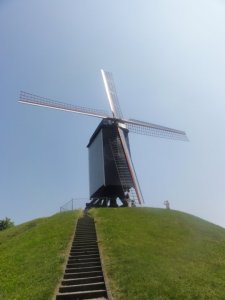 We left Paris early on our first leg of the Busabout tour. The bus was quite comfortable. It only took 4 hours to get to Bruges, and I was delighted to find it a very relaxed, quiet town. Our accommodation was pretty impressive for the price. Once we had checked in and offloaded our luggage we resolved to wander the streets, sampling a large array of exotic Belgium beers along the way.
We left Paris early on our first leg of the Busabout tour. The bus was quite comfortable. It only took 4 hours to get to Bruges, and I was delighted to find it a very relaxed, quiet town. Our accommodation was pretty impressive for the price. Once we had checked in and offloaded our luggage we resolved to wander the streets, sampling a large array of exotic Belgium beers along the way.
Everything in Bruges seems to be quite cheap – a very generous portion of tasty Spaghetti Bolognese cost me a total of 5 Euros at our hostel restaurant. A pint of delicious Leffe Dark costs all of 2.5 Euros (which works out to be about $5 Australian. You’d usually expect to pay around $18 for that beer). A pint of Hoegaarden? A mere one-Euro-fifty.
The word around the town is that most locals do not like tourists. That assessment feels about right. Some of the locals were fairly cold to us – but I’m not sure I blame them once you consider that their idyllic, peaceful little town has been transformed into a tourist-infested boozefest. It must be said that perhaps an equal proportion of locals were actually quite helpful and friendly. In one pub we met a very nice local chap who insisted we must try his favourite beer (‘Roscherfield’ or something similar). A few moments later two pints appeared in front of us – he’d bought us two of them to try it. We chatted to him for a good hour or so.
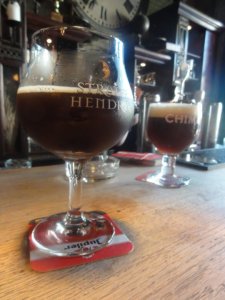 The night slowly turned hazy – as one would expect when spending countless hours drinking extremely heavy, strong Belgium beers with enough alcohol content in them to stun a moose. It must be said I invariably went for the most adventurous, strangest or strongest beers from whatever menu was thrust in front of me. There was definitely a threshold that was met and surpassed with reckless abandon. At one point we entered another pub in our seemingly endless succession of pubs. I ordered 2 pints while Matt went to the bathroom.
The night slowly turned hazy – as one would expect when spending countless hours drinking extremely heavy, strong Belgium beers with enough alcohol content in them to stun a moose. It must be said I invariably went for the most adventurous, strangest or strongest beers from whatever menu was thrust in front of me. There was definitely a threshold that was met and surpassed with reckless abandon. At one point we entered another pub in our seemingly endless succession of pubs. I ordered 2 pints while Matt went to the bathroom.
Then, he disappeared.
I found myself entirely alone in a strange Belgium pub, considerably intoxicated and holding two oversized and overproof pints of murky dark beer. I resolved not to let them go to waste and struck up a conversation with two girls who also happened to be from Australia. We were later joined by four Spaniards. We drank, conversed and generally enjoyed the pleasing effects of alcohol together before I decided to make my way back to the hostel. Matt was sound asleep, and treated me to another enthralling round of cacophonous snoring. It was about this time that I thanked Saint Christopher (the patron Saint of travel) for my enclosed headphones. I drowned out his inebriation with the soothing sound of Bohren & Der Club of Gore. All in all the night was an immense success.
26/06/10 – Bruges, Belguim.
I awoke to white hot flashes of pain driving into my skull like a screwdriver. They seemed to scream at my mind: agony, pain and agony again. I was in the midst of a very severe hangover. Obviously the highly-alcohol content of Belgium beer does your brain absolutely no favours. The majority of the day was spent in various dramatic positions intended to portray my agony on the floor next to my bed. I supplemented the pain with doses of Tim & Eric’s Awesome Show: Great Job and The Venture Bros.
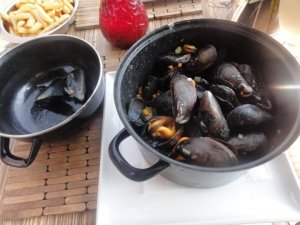 We eventually worked up the requisite momentum to get some lunch at around 3pm. I had a delicious pot of mussels – which is definitely a local specialty. The pot was enormous, almost comical in size. We were treated to a series of glances registering mild contempt and general distaste from our waiter. The next few hours were spent wandering through the main streets and markets of Bruges as we stopped off occasionally to look inside some of the many medieval chapels and churches. One purported to have an actual drop of the blood of Jesus Christ. I find the claim dubious personally – but why would they lie about such a thing? At the very least I think it could make for a very entertaining world-domination scheme for a rogue super-scientist.
We eventually worked up the requisite momentum to get some lunch at around 3pm. I had a delicious pot of mussels – which is definitely a local specialty. The pot was enormous, almost comical in size. We were treated to a series of glances registering mild contempt and general distaste from our waiter. The next few hours were spent wandering through the main streets and markets of Bruges as we stopped off occasionally to look inside some of the many medieval chapels and churches. One purported to have an actual drop of the blood of Jesus Christ. I find the claim dubious personally – but why would they lie about such a thing? At the very least I think it could make for a very entertaining world-domination scheme for a rogue super-scientist.
In any case, we spent the last few hours of the afternoon trying to convince ourselves that we did not just waste an entire day in Belgium being hungover – but to little avail. I was not feeling particularly good, and I really don’t think I could absorb any of the sights in any meaningful fashion.
 I miss Monika very, very much. I found that whenever I was exposed to an amazing, inspiring or generally impressive sight I couldn’t help but think to myself how greatly improved the situation would be if Monika was here to share it.
I miss Monika very, very much. I found that whenever I was exposed to an amazing, inspiring or generally impressive sight I couldn’t help but think to myself how greatly improved the situation would be if Monika was here to share it.
I am still exhausted; lying in bed as I type this and flicking through Ted Hughes’ incredible collection of poems called The Life and Times of Crow. Today I also started reading Fyodor Dostoyevski’s Notes from the Underground, attempted to write a short poem and drew for all of 20 minutes. The latter was pretty much a failure.
We had a fairly cheap dinner at the Bauhaus restaurant just next to our hostel. Matt had a traditional beef stew cooked overnight in a dark lager which was absolutely amazing. We called it an early night and went to sleep.
27/06/10 – Bruges, Belgium.
We awoke early to meet a tour bus that was to take us around various World War 1 battlefields including Ypres, Paeshendaele, the Somme and Flanders Fields. Our tour guide was a very knowledgeable and passionately-animated Belgium man who runs the tour company with his Australian wife. Our tour group comprised of only 17 individuals, and – aside from one young Canadian – we were the only people under 45 years of age who had signed up. That is quite a sad fact upon reflection. I can vividly recall my sense of outrage when we booked the tour from our Busabout bus en route to Belgium; Matt and I were the only two of the forty young Australians onboard who were even mildly interested to see where millions had lost their lives in unimaginable misery. Conversely, a huge amount of people were extremely excited to learn they could do a walking tour based around Colin Farrell’s recent movie “In Bruges”. What a fascinating microcosm for the culture of youth.
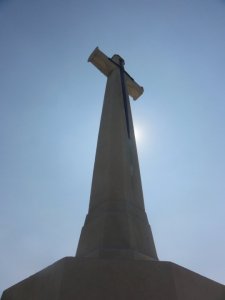 The day was fairly sombre. I felt as though I was finally going to gain some sense of this monolith of history that had cast a shadow over so many nations. Matt said he’d been waiting to go to where World War 1 was fought for at least eight years. For our first stop we walked over the treacherously flat fields where the Battle of Paeshendaele took place – in which almost half a million people lost their lives. We learnt one particularly astounding fact: since 2.5 billion shells (yes – two-point-five BILLION shells) had been fired in Belgium and France during the Great War the countryside is still littered with live, undetonated shells even to this day. Enough shells were dropped in the Belgium countryside to make three for every square metre of earth. Consider that for a second.
The day was fairly sombre. I felt as though I was finally going to gain some sense of this monolith of history that had cast a shadow over so many nations. Matt said he’d been waiting to go to where World War 1 was fought for at least eight years. For our first stop we walked over the treacherously flat fields where the Battle of Paeshendaele took place – in which almost half a million people lost their lives. We learnt one particularly astounding fact: since 2.5 billion shells (yes – two-point-five BILLION shells) had been fired in Belgium and France during the Great War the countryside is still littered with live, undetonated shells even to this day. Enough shells were dropped in the Belgium countryside to make three for every square metre of earth. Consider that for a second.
Every year fatalities are still recorded without fail as luckless farmers disturb undetonated shells with their tractors and ploughs. The farmers have been instructed to leave whatever shells they find by the side of the road for the army to pick up and safely detonate nearby – however; amongst these explosive shells are chemical shells, filled with chlorine or mustard gas which are not so easily disposed of. These chemical shells have not been able to be properly detonated and disposed of until very recently. We were also told of locals who have the extremely dangerous – but apparently lucrative – hobby of illegally collecting these shells for profit. Many will try to defuse them on their own. One of the guide’s friends had left two shells to be picked up by the army that very morning. They were stolen a few hours later by an old man on a push-bike who carried off the unstable shells in a flimsy woven basket.
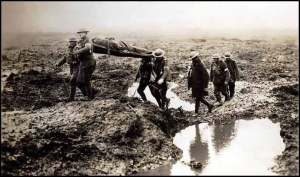 It was remarkable to see how flat the Belgium countryside really is. The ground itself is comprised predominately of clay, so when exposed to constant shelling and rain most of the country is reduced to a vast, sickening black clay mud-pit of misery. Immeasurable numbers of men literally drowned in that mud. Wooden tracks had to be set up for supply lines and troops to march across. It was said that if you had a friend fall off the track and into the quicksand-like mud, you were under orders not to attempt to rescue them. Quite simply, they would not be getting out again unless they were able to jettison their 30kg packs within the first crucial seconds. Upon falling prisoner to the mud, many soldiers begged their friends to shoot them rather than face a slow death by drowning.
It was remarkable to see how flat the Belgium countryside really is. The ground itself is comprised predominately of clay, so when exposed to constant shelling and rain most of the country is reduced to a vast, sickening black clay mud-pit of misery. Immeasurable numbers of men literally drowned in that mud. Wooden tracks had to be set up for supply lines and troops to march across. It was said that if you had a friend fall off the track and into the quicksand-like mud, you were under orders not to attempt to rescue them. Quite simply, they would not be getting out again unless they were able to jettison their 30kg packs within the first crucial seconds. Upon falling prisoner to the mud, many soldiers begged their friends to shoot them rather than face a slow death by drowning.
It’s hard to imagine now, but there was absolutely nothing left of the Belgium countryside during the war apart from mud, debris, and charred trees. Barely a shrub – let alone a patch of grass – remained. It was as if organic life had been expelled. The countryside was transformed into a scene from Dante’s’ Inferno – a grotesque sea of black, formless sludge littered with millions of unburied, decomposing bodies. If that is not an image of hell on earth, then I do not know what is. We listened to the story of how the Germans bitterly introduced gas into the war. The mustard gas used ultimately seeped into the mud to harm those crawling through it months – perhaps even years – later. The ground was literally as poison sludge. The English, Canadian and ANZAC troops were initially without gasmasks; forced to make panicked, rudimentary replacements.
We heard stories of how General Hague emotionlessly sent wave after wave of troops into various massacres over the war. The average age for a soldier was 20 – and a considerable proportion of those who died were under 16 years of age. More distressing was the fact that at the time, shellshock was not understood as a medical condition; it was viewed as cowardice in the British army, and many of the young boys who suffered from it were executed by their own country. More bitterness spread when news of German soldiers making their bayonets jagged was passed around. The jagged blades create wounds that would not heal; giving those stabbed no chance of survival. If captured enemy soldiers were found to be in possession of jagged bayonets they were not taken prisoner – they were shot on the spot.
The sheer number of unmarked graves representing those forever lost in action is staggering. We visited Hill 60 – one of the highest points in the Belgium countryside at 60m about sea level. Hill 60 was taken from the Germans when the Australian Mining Corp tunnelled under German positions very gradually for 18 months, then exploded a series of extremely powerful mines underneath them. The explosions immediately killed 600 troops and traumatised many others. That day, the Australian troops marched on the hill to find the Germans without fight; they gave themselves up in tears; deafened or blinded from the blast. That manoeuvre is regarded as the most successful military operations from World War 1. We visited Hill 60 in its preserved form, observing firsthand the land deformed with craters from shell blasts and detonated mines.
We visited a number of major memorials for the war as well as a war museum in Ypres (I love that word so much; it is pronounced “Yeep”). We stopped by a farmhouse which boasted a considerable collection of shells as well as some amazingly fresh strawberries. We visited a restored British trench. Shockingly it is the only trench still intact in the entire country. All of the preservation work was done by a group of seven volunteers without any help from the Belgium government. Our tour guide was quite bitter on this point. He explained that even now the government refuses to contribute to the upkeep of the trench, the result being that the dugout is completely filled with water – a relic left to rot away. We also visited the township of Ypres which was completely flattened during the war, only to be rebuilt to the original medieval plans wherever possible.
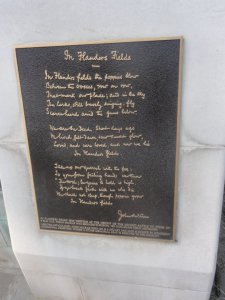 The countryside is also still littered with bodies. The government proposed to build a highway out to the sea, but these plans were met with a very vocal protest when it was estimated at least 1,000 buried bodies would be disturbed in the process. That is not exactly a problem that most nations face. The amount of corpses that still litter the countryside – some only buried 50cm beneath the surface – are a sad reminder of that disgraceful failure of humankind. Many bodies are still uncovered each year by farmers and construction workers.
The countryside is also still littered with bodies. The government proposed to build a highway out to the sea, but these plans were met with a very vocal protest when it was estimated at least 1,000 buried bodies would be disturbed in the process. That is not exactly a problem that most nations face. The amount of corpses that still litter the countryside – some only buried 50cm beneath the surface – are a sad reminder of that disgraceful failure of humankind. Many bodies are still uncovered each year by farmers and construction workers.
One of the last sites we saw was a preserved British bunker, built on top of a German pillbox at Hill 60. We finished off the tour by visiting the ‘Advanced Medical Dressing Centre’ where the famous medical officer John McCrae wrote his poem ‘In Flounders Fields’. If you’re not familiar allow me to reproduce it here. I quite like it.
In Flanders fields the poppies blow
Between the crosses, row on row,
That mark our place; and in the sky
The larks, still bravely singing, fly
Scarce heard amid the guns below.We are the Dead. Short days ago
We lived, felt dawn, saw sunset glow,
Loved, and were loved, and now we lie
In Flanders fields.Take up our quarrel with the foe:
To you from failing hands we throw
The torch; be yours to hold it high.
If ye break faith with us who die
We shall not sleep, though poppies grow
In Flanders fields.
Once more we had quite a sobering experience as we walked around the crude “medical centre” where thousands would have died in agony – bleeding to death or suffering amputations without the aid of any painkiller. I was very pleased to find that – in stark contrast to the grim nature of the tour –the Belgium countryside hosted a beautiful range of flowers that dot the flat landscape with vibrant purples, yellows, reds, pinks, oranges and blues.
That night we dined at a fairly fancy restaurant and enjoyed a very nice meal of mussels, shrimp and lobster with a very tasty rosé. After the meal Matt again invited me to sample his snoring prowess. I estimate he literally disturbed me from sleep at least 25 times. I’m starting to wonder when I’m going to get a reasonable night’s sleep again on this trip. One of our neighbours next door is a small child who likes to shriek and cry and scream hysterically at fairly regular intervals, and at extremely loud volumes. Bless his heart the little tyke.
Tomorrow around midday we leave for Amsterdam in The Netherlands – the country of my grandmother’s origin.
Lachlan’s Exhilarating European adventure
Picturesque Paris: Part 1 of Lachlan’s Exhilarating European adventure
20/06/2010 – Kuala Lumpur, Malaysia.
I got my first taste of feeling like an intruder in another culture in Kuala Lumpar. I passed an Islamic prayer room shortly before prayer time, and I was most certainly not welcomed with accommodating or appraising expressions by the faces of the assembled Malay Muslims.
21/06/2010 – Paris, France.
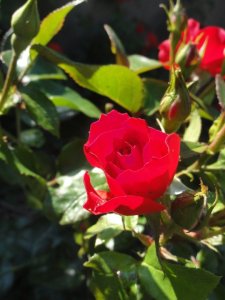 We arrived in Paris at around 6am, and were surprised to find how lax their airport security and customers were – especially in comparison to the obsessive paranoia of Australian customs. We decided to wander the Paris streets fairly randomly from our hotel in the Bohemian district of Montmartre. We came across a little sidewalk cafe in an alleyway off the main street where we ate our first Parisian meal – the national dish of steak and chips coupled with the most expensive red wine (30 euro) on the menu. The red wine was simply amazing, and we topped it off with one of the most amazing cappuccinos’ I have ever had the fortune of drinking. The waiter too, was charming, polite and extremely accommodating. ‘So much for the rudeness of the French’, I thought. This was perhaps the best possible introduction to Paris we could have hoped for. I wish we had actually taken note of where that cafe was as we would have liked to have returned to show our gratitude.
We arrived in Paris at around 6am, and were surprised to find how lax their airport security and customers were – especially in comparison to the obsessive paranoia of Australian customs. We decided to wander the Paris streets fairly randomly from our hotel in the Bohemian district of Montmartre. We came across a little sidewalk cafe in an alleyway off the main street where we ate our first Parisian meal – the national dish of steak and chips coupled with the most expensive red wine (30 euro) on the menu. The red wine was simply amazing, and we topped it off with one of the most amazing cappuccinos’ I have ever had the fortune of drinking. The waiter too, was charming, polite and extremely accommodating. ‘So much for the rudeness of the French’, I thought. This was perhaps the best possible introduction to Paris we could have hoped for. I wish we had actually taken note of where that cafe was as we would have liked to have returned to show our gratitude.
From there we walked the main streets, occasionally stopping for a beer or an espresso in one of the multitude of sidewalk cafes. I could definitely see their attraction for writers like Camus; you could enjoy a coffee and a cigar outside in peace without any pressure to move on whatsoever.
We stumbled across a Dali exhibition in a heritage listed mansion/house previously owned by a French aristocrat in the 1800s. To call the mansion opulent would be an understatement; the ceilings towered over us; each room was decorated with complex awnings, gold trim, large grandiose paintings, weavings… some rooms were adorned with gigantic artworks on the ceiling and marble sculptures and furniture. Most astonishingly was that each of the twenty-plus rooms were decorated in a completely unique style. The entire establishment boasted obscene opulence.
Upstairs in the separate gallery we were treated to a handful of Rembrandts and Picassos amongst fairly bland Romantic-era portraits. Disappointingly, the Dali “exhibition” amounted to little more than five pieces that were randomly distributed about the gallery – though admittedly two of the pieces were amazing, and I was also able to see my first Dali sculpture.
We wandered up to Napoleon’s epic Arc de Triomphe – a monument to his many victories (its completion was delayed or slowed when he started losing battles, Matt confided in me. “He wasn’t that great” he dismissed, clearly unimpressed.). On the way we saw St. Augustine’s Chapel. By the time we reached the Arc we were jet-lagged and exhausted, so we decided to head back to the hotel. It dawned on us that we had randomly meandered some 10km from our place of departure and resolved to attempt to use the French subway. The experience was brief and bewildering. It didn’t take long for us to cut our losses and opt to walk the long two hours home. Fatigued and in an ever-increasingly foul mood, we managed to get lost in the tangled maze of alleyways and backstreets near our Hotel du Lausanne, which was extremely frustrating. I collapsed, sleeping for 13 hours.
The Parisians we encountered were friendly, and the language barrier was essentially non-existent. So much for that myth.
22/06/2010 – Paris, France.
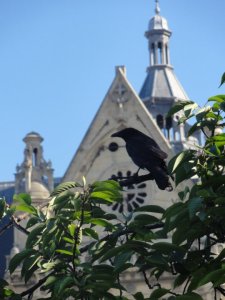 We woke up at 6am and grabbed breakfast at a nearby bakery for a mere 2 Euros. We walked to the Louvre before we irritatingly discovered that it was closed on Tuesdays. I felt qualified to say this much though; the new pyramid structure in front of the Louvre is an abortive eye-sore that should be torn down. It has no place amongst the majestic three-hundred year old sandstone fortification that surrounds it. Consider me not amongst its fans.
We woke up at 6am and grabbed breakfast at a nearby bakery for a mere 2 Euros. We walked to the Louvre before we irritatingly discovered that it was closed on Tuesdays. I felt qualified to say this much though; the new pyramid structure in front of the Louvre is an abortive eye-sore that should be torn down. It has no place amongst the majestic three-hundred year old sandstone fortification that surrounds it. Consider me not amongst its fans.
We took a scenic walk through the nearby gardens, stopping occasionally to relax and ponder. The sun was out and the weather was indescribably perfect; there was neither humidity nor scorch to the sun, and we were relieved by a light cool breeze. We eventually wandered up to the Eiffel Tower to be hassled by an endless succession of men selling tacky Eiffel Tower models and keyrings. Afterward we found a little tucked away alleyway that perfectly fit my dreaming of a typical Parisian lane; dotted with colourful cafes and clothing stores beneath classically French unit blocks, with most windows adorned with a simple and elegant red rosebush.
We ate a meal of Duck and Steak Tartar in a popular cafe, alongside the best Rose’ I have ever sampled. After that we resolved to get drunk; wandering randomly in the alleyways off le Saint to whichever bar or cafe looked nice for a beer. We caught the closing minutes of France playing South Africa in the World Cup. One cannot understate the general contempt the French have for their team. Their highly publicised team turmoil is widely regarded as a disgrace to the nation, and we were both surprised to discover the extent of this disappointment. Their perceived fall from grace far outweighed any sense of sporting patriotism. Respect is such a key feature of French society; it suddenly became very clear why the loud, brash engagement-strategy of most American tourists is met by a slight but cold offense.
By the time we had dinner across the street from our hotel in Montmartre we were half cut. The waiter was extremely friendly and went out of his way to ensure we were comfortable. We had escargot as an entree (which tasted of little more than butter and garlic), followed by a steak and a chicken pasta dish. We ordered a 60 euro bottle of Champagne – which was nice, but not as nice as the price should indicate. We left around midnight – quite drunk.
Most Parisian’s have a certain ‘look’ about them; thin, slightly tanned, dark hair and brown eyes – slightly effeminate. The rumours of the English/French language barrier – as well as the general rudeness and arrogance of Parisians – seems to be fairly unfounded (unless, like many Americans, you don’t show a basic level of respect and politeness, and at least a symbolic attempt to communicate in their language). We only knew some very basic phrases in French, and so far that has been more than enough to get us by quite comfortably without feeling rude, alienated or ostracized.
After being dwarfed by monuments, statutes, fortresses and buildings up to 500 years old for the first time one tends to get a little disorientated. It definitely affects the scale on which you perceive yourself, and with which you perceive general cultural history. It inspires a sense of awe and a slight feeling of helplessness.
23/06/2010 – Paris, France.
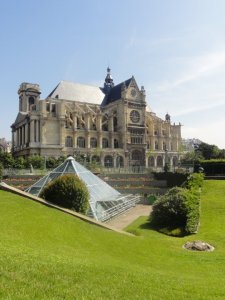 We started off this morning as we did the one before; with a few freshly baked croissants from a bakery a few doors from out hotel for a euro a piece – absolutely delicious and very kind on the budget. We moved up a few streets to quaff some unfortunately sub-par and expensive coffee (5 Euros each) before slowly wandering down to the Louvre. We stopped at a few clothing stores along the way and it didn’t take long for us to dawn on us that cheap clothing, sunglasses and footwear are essentially non-existent in Paris; you pay for the real thing or you go without. Style and authenticity are certainly an obsession.
We started off this morning as we did the one before; with a few freshly baked croissants from a bakery a few doors from out hotel for a euro a piece – absolutely delicious and very kind on the budget. We moved up a few streets to quaff some unfortunately sub-par and expensive coffee (5 Euros each) before slowly wandering down to the Louvre. We stopped at a few clothing stores along the way and it didn’t take long for us to dawn on us that cheap clothing, sunglasses and footwear are essentially non-existent in Paris; you pay for the real thing or you go without. Style and authenticity are certainly an obsession.
The line at the Louvre was surprisingly small and fast-moving. Once more that horrid pyramid offended my senses as we paid for entry and started exploring Italian Renaissance, ancient Greek and Roman sculptures. The sheer size of the Louvre is obscene. One of the moments that stood out was the sheer sense of disappointment upon seeing Michelangelo’s Venus de Milo. The line around that most famous sculpture was substantial. As we worked to position ourselves I was quite surprised to see Venus’ large, malformed, ugly hips absolutely lacking in grace and her head several times too small for her body. It was essentially, a very poorly scaled piece in what should hark back to the perfect dimensional ideals of ancient Greece and Rome. Once more, the reality clashes violently with the hype. Most buy it. Conversely, Matt and I were quite pleasantly impressed with Da Vinci’s Mona Lisa, which was larger than expected. It had a strangely captivating air.
After racing around most of some of the Louvre we looked for lunch – extremely grateful to escape the throngs of braying chattel. We found a very nice little restaurant a few streets off the Saint; Matt enjoyed a superior Steak Tartar, at the completion of which he announced that it would be his death row meal, and he would refrain from ordering it again in France as the ‘standard was now set too high’. Admittedly, it was fantastic – I also had a fairly satisfying veal dish.
From there we strolled in the sun to Notre Dame, stopping on the way to buy some artwork off a very talented riverside artist. Notre Dame was the single most awe inspiring site of my life; it inspires the kind of awe that I think is worthy of religion’s ideals. The fact that the Gothic cathedral took 200 years to build reinforces the innumerable life-works and the pious dedication that went into its construction. As soon as we entered my mouth was literally left agape in reverence – and did not close until we left many minutes later. I did not even want to speak out of respect. I even considered speaking to a priest in private to peer into his mind, but thought the better of it in reflection of my own beliefs. We circled the awesome cathedral’s interior twice before resolving to return tomorrow to climb its summit. For at least half an hour afterward I was almost silent. That cathedral had a profound effect on both of us. We would return tomorrow.
We headed back to our hotel once more to sit across at the cafe we dined at last night. Outside in the sun we smoked a large cigar each – again, by far the best we have ever had. We spent the light hours of the evening slowly sipping beer and cocktails while reading outside, absorbed in a very contented sense of satisfaction and relaxation. I reflected that life is a hard and drudging affair when you’re placed in such an environment. I finished off Aldous Huxley’s Doors of Perception, which contained no small amount of insight.
Later on we both lay on our beds while watching BBC News and CNN while slowly drinking a Boudreaux we picked up on Tuesday for 10 Euros. It is very, very easy to drink. Then Matt is snored excessively.
24/06/10 – Paris, France.
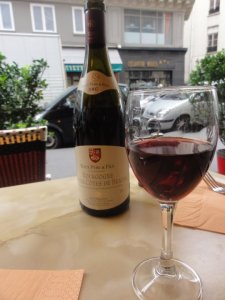 Well, that was our last night in a hotel – from here on out it’s nothing but hostels until I get to London. We got up early and did some laundry while eating croissants from the local bakery. At the Laundromat we met a middle-aged Australian couple who had been travelling all over Scotland and Ireland.
Well, that was our last night in a hotel – from here on out it’s nothing but hostels until I get to London. We got up early and did some laundry while eating croissants from the local bakery. At the Laundromat we met a middle-aged Australian couple who had been travelling all over Scotland and Ireland.
We did a little bit of shopping and I found myself a decent dress shirt (should we want to go out to any clubs or restaurants with a dress code). Our plan was to head back and climb Notre Dame, however we ended up fairly far astray in the sweltering heat. I guess it was only a matter of time until we had our first experience lost in another country.
For a few hours we tried to get a cab to Notre Dame or back home to no avail. A cab driver muttered something about a strike. We came across an enormous Socialist protest or parade at the government house, and then flustered and frustrated, we decided to brave the metro to get back to our hotel where we ordered a cab to take us to our hostel at St. Christophers. Being hot, irritable and exhausted it was a great relief to find everyone spoke English at the hotel – and that most were American, English or Canadian.
We walked up the river to find a little French/Jewish restaurant. We were the only gentiles in the packed-out dining room, and had a nice meal of assorted grilled meats.
I can see why so many people fall in love with Paris; the sheer joy of good food, wine and coffee is intoxicating. The sidewalk cafe culture is infinitely superior to fast-food, and the general quality of food and drink is much higher. The streets are filled with classy buildings hundreds of years old, and are uncluttered by street-lights and power cables.
What one also notices is the total absence of American styled invasive marketing. Even along the main strip there was barely an advertisement to be seen – what bliss. We could identify no major retail chains, nor could we find anything resembling a shopping centre. I love Paris. I will definitely return. Even the language is appealing. Not once did we encounter anything resembling “typical” Parisian rudeness.
Tomorrow we leave for Bruges, Belgium.
Lachlan’s Exhilarating European adventure
4 comments